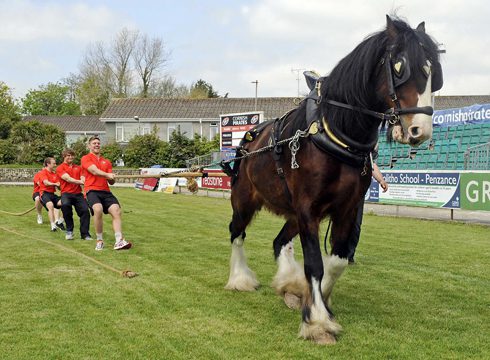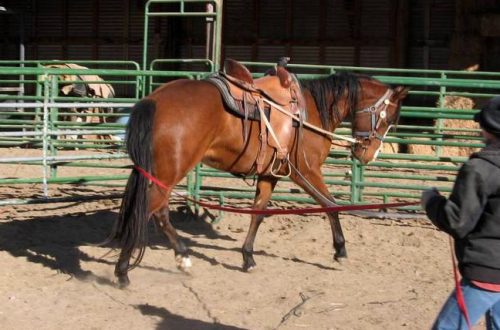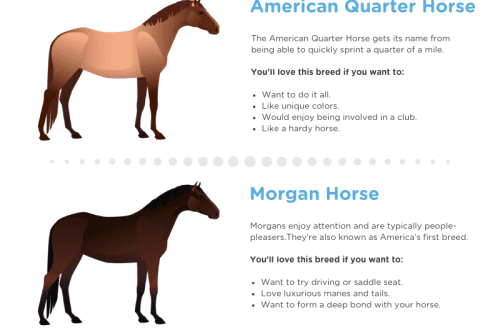
Do not “tug of war” with the horse!
Do not “tug of war” with the horse!
Riding a horse that is constantly trying to take the reins away from you is not a pleasant experience. Reese Koffler-Stanfield (Grand Prix-level dressage rider) shares with readers tips to help stop constant rein-tugging and get your horse back on track.
Лthe house is in the front
Horses that pull your arms down, lean on the reins, or are just tight-knuckled horses are most often rebalanced to the front. They say about such horses that they are in the front, i.e. while driving do not connect the hind legs, back and lower back correctly. Their gaits are lean and devoid of momentum.
“It’s really a problem that when a horse learns to hang on his hands, he also learns that he does not need to fully work,” says Reese Koffler-Stanfield. With over a hundred muscles in the neck muscles alone and a weight more than 5 times the rider’s weight, the horse must carry itself and not leave the task to its rider. Before your horse learns to hang on the lead, you must train him to carry his own weight and yours.
Correct landing
The starting point is your position on the horse. What usually happens if a horse on the forehand pulls the rider with its jaw on the reins? The body of the rider leans forward, the legs go back. The balance is disturbed and the horse cannot connect the butt to the work. To help your horse learn to shift weight back, start by checking your position in the saddle. A straight line should go through your ear, shoulder, thigh and heel, and a straight line should be maintained from the snaffle to the elbow. “This checklist is a great way to check if you’re sitting correctly,” said Reese Koffler-Stanfield.
Using the right fit
The correct position of the rider on the horse provides him with a strong, stable and independent seat. So, he will be able to effectively use the controls. In this case, you should do half-halts. Half halts are needed to restore the balance of the horse, to shift the balance from front to back.
Before doing a half halt, make sure you are sitting properly and then close your leg, sluice and hands. Moving from the hindquarters requires a certain muscular effort from the horse and is not easy for him. You also need to be physically fit to keep the horse on its hindquarters. In the half halt, feel the muscles in your abs, back, and lower back tense. For horses that have been moving on the forehand and hanging on their hands for quite a long time, half halts will not be enough. In this case, transitions will come to your aid. Make transitions from gait to gait, from gait to halt and back, and transitions within a gait. If this problem is not addressed, the horse will become more and more heavy on the bit.
Transition to success
Start with step-stop-step transitions. You may need to make over a hundred of these transitions before you get your horse moving from the hindquarters. Use your loin and back to force the horse to come in more and disengage from your hands. When stopping, the horse should remain in rear balance, and not dig into the ground in front, hanging on your hands. Next, continue to work with the trot transitions. Trot-walk-trot and trot-stop-trot. Control the horse in the same way as on the walk. Before crossing, check if the horse is carrying itself. Performing transitions at a canter, first making them inside the gait. As you canter, ask your horse to step up. The increase should be carried out not by increasing the rhythm, but by increasing the tempo of the canter. horse on raise should push wider. Then shorten it again. If the emphasis on the arms increases during cantering, increase the force of the message.
Twists on the back
Another effective exercise is turns on the back. Start walking along the short side of the arena. Before turning into a long stop the horse and make a turn on the back, continue moving along the long wall. Make a turn in each of the corners of the arena.
Once you have mastered this exercise at the walk, try it at the trot as well. Before turning, do a half halt, bring the horse to a walk, or immediately stop and ask for a turn on the hindquarters.
In conclusion
Horses that hang by their hands are not strong enough to carry their weight on their own and move from the hindquarters. You must be patient as you build up this power. Be consistent in your work. Your role as a rider is extremely important. You must show your horse how to move correctly, see the slightest change for the better and be sure to praise him. Your goal is to gradually bring the horse to the balance you want on the hindquarters. In order for the horse to be able to do this physically, it must build up a certain amount of muscle mass. It’s not just about understanding what the rider wants from her. Don’t force. Muscle growth is not a fast process. An indicator of successful work will be a feeling of lightness in front. The horse will begin to include the back, lower back, move from the back. You, as an attentive rider, will immediately feel these changes.
Be patient and the result will not disappoint you.
Natalie DeFee Mendik; translation by Valeria Smirnova (material was published on the site http://www.horsechannel.com/)





